We then walked under the road (25 levels above us) over to tunnels alongside the back of the dam. There was the low rumble of water going into the generators, and John said that sometimes you could even hear the traffic above. There was also what sounded to be... a distant waterfall! Apparently 150 gallons of water trickle through the dam per day. Gutters along the floor help channel and send it to the center of the dam.

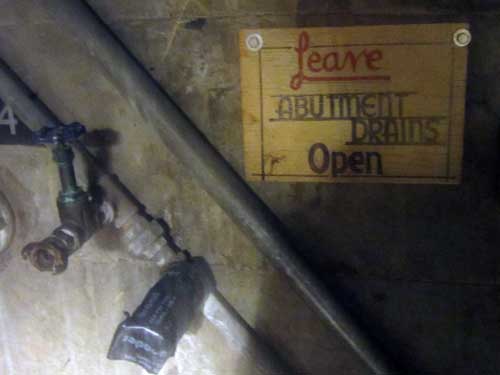
We stopped at a long, steep set of stairs that went 49 levels down and 25 levels up. From bottom to top it's about a 2 hour climb. I have to assume this is more for emergency in case the elevators stop working!
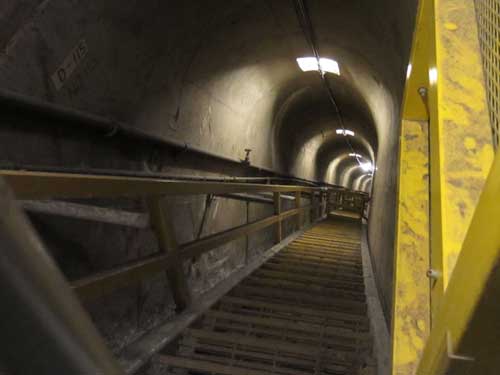

We then entered our final elevator to the top. All of the decoration was original from the 1930's.

At every elevator stop, John had to call in and report our progress.

Brass doors on the front...
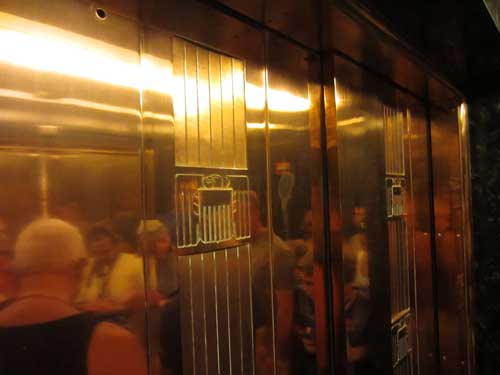
... and bronze ones on the back
Much of the dam's decoration is done in Art Deco, a modernist style of architecture and design that was popular in the 1920's and 30's. It first appeared in France just before World War I and influenced everything from buildings and trains to jewelry and vacuum cleaners. It name comes from the "Exposition Internationale des Arts Decoratifs et Industriels Modernes" (International Exhibition of Modern Decorative and Industrial Arts) which was held in Paris in 1925.

The pattern in the marble is symbolic of a generator.

Leaving the elevator

The bas-relief sculpture on the elevator tower was created by Oskar J.W. Hansen. (Click for a larger view of the sculpture)
The tour left us off on top of the dam.
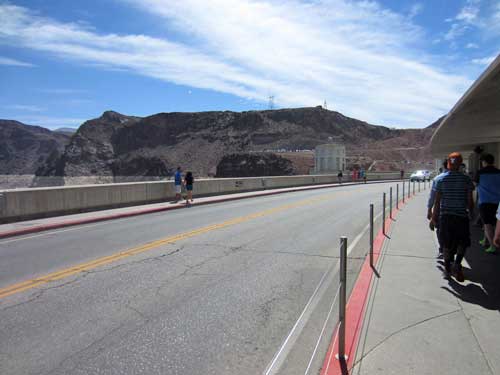
The road on top of the dam

Marking the state border

A glimpse over the front toward the Arizona side...

... and toward the Nevada side
Height of dam: 726 feet
Length of crest: 1244 feet
Thickness at top: 45 feet
Thickness at base: 660 feet
Hoover Dam is a 'free-floating arch-gravity' dam. The free-floating means it is not anchored to the riverbed or the canyon walls. An arch-gravity dam has the characteristics of both an arch dam and a gravity dam.
An arch dam is curved toward the upstream side. It is designed so that the force of the water presses against the arch, thereby compressing and pushing the dam into its foundation. Basically the water holds it in place. The arch shape helps distribute the 45,000 pounds of pressure per square foot.
A gravity dam primarily utilizes the weight of the concrete to hold it in place (aka the force of gravity). In this case, that's 6.6 million tons (or the equivalent of 18 Empire State buildings). Gravity dams are designed so that each section is stable. Built in giant individual blocks, the dam can move and twist without snapping. The dam is VERY strong and made using the best concrete available in 1931. In theory, it could last 2,000 to 2500 years.

The Mike O'Callaghan–Pat Tillman Memorial Bridge
Originally, all traffic drove across the top of the dam via US 93. Steep roads and hairpin turns, combined with ever increasing pedestrian and tourist traffic, led to major traffic jams. Plus there were security concerns as well as the risk of a vehicle accident directly on the dam. An alternative route for through traffic was clearly needed. Construction on the bypass bridge began in 2003 and was completed in 2010. I is the second-highest bridge in the US and the world's highest concrete arch bridge.

Looking down at the power plant


Looking over the back of the dam at Lake Mead. Buried deep below the surface are still the railroad tracks and even railcars that were used to build the dam.
Lake Mead is the largest reservoir in the US by volume (when full at over 9 trillion gallons). It took 6 1/2 years to fill after the dam was operational. It is currently only 36% full... the lowest it's ever been since it was formed. This is a combination of a 15 year drought and increased demand (now serving 25 million people in Nevada, Arizona and California).

Because the lake fills a canyon rather than a bowl or basin, it is far deeper than many lakes.
Most of the water comes from snowmelt in the Rocky Mountain range, which travels through Lake Powell and the Grand Canyon.

The Colorado River basin (click for a larger view)


The Nevada side intake towers

The four intake towers are made of reinforced concrete and are 395 feet tall and 63 feet wide at the top.

While it may look like the towers are floating, they actually sit on the canyon walls.



Each tower contains over 15 million pounds of steel.

Two 32-foot diameter gates in each tower control the flow of water into the penstocks. They take in water deep below the lake's surface to reduce the chance of drawing in fish and debris.
I left the top of the dam and headed toward the visitor center, stopping at a few interesting spots along the way.

Oskar J. W. Hansen (1891 - 1971) was the designer of Monument Plaza. It includes the 'Winged Figures of the Republic' and the zodiac compass.

The 30-foot tall figures contain more than 4 tons of statuary bronze. The bronze shells were formed by pouring bronze, heated to 2,500 degrees Fahrenheit, into sand molds weighing 492 tons. According to Hansen, they express "the immutable calm of intellectual resolution, and the enormous power of trained physical strength, equally enthroned in placid triumph of scientific accomplishment."

Seven states symbols (those effected by the Colorado River) are displayed.

In order to not scuff the finishes of the black diorite cubes, they were set on blocks of ice and guided into place by hand as the ice melted.
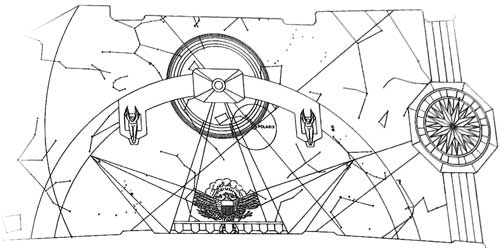
A layout of the plaza

The plaza also includes a star chart of the heavens on September 30, 1935, the day the dam was dedicated.

Hansen designing the star chart in 1938


This is the grave of the Hoover Dam dog... a self-appointed dam guardian.

Found as a puppy by workers at a construction camp, he wandered freely about the site, chased ringtail cats through the tunnels, traveled on the bus to the work site with the other employees, and even rode in the open-air elevator. Unfortunately he was run over in 1941 when he fell asleep under a truck.

Being continually overfed by workers, his diet was eventually limited to one meal a day, which he carried to the job in a paper sack.

High Scaler, sculpted by Steven Liguori in 2000, honors those who did this dangerous job. One high scaler was quoted as saying "they hired anyone who didn't have brains enough to be scared."

'Scaling' is the process of removing loose rock from a cliff face. Men, dangling from ropes high on the cliff, would use jackhammers to drill holes for dynamite. After the blast, they returned to pry off loose rock.
How many people died building the dam? That number ranges, depending on how you define it. The official number of fatalities is 96. These were men who died at the dam site from 'industrial fatalities'... drowning, blasting, falling rocks or rock slides, falls from the canyon walls, being struck by heavy equipment, truck accidents, electrocution, crushed by wet concrete, etc. It even includes people killed on a river survey 8 years before construction began. But it doesn't include deaths from heat, pneumonia, heart trouble, and so on. Nor does it include all those who were injured at the dam site while working there but didn't die there (for example at the hospital or after they were discharged).
Interestingly, the first man to die in Black Canyon in connection with the project was J.G. Tierney, who fell of a barge during a geological survey and drowned in 1922. Thirteen years to the day, his son, Patrick W. Tierney, fell from one of the intake towers and died.
In the visitor center, the exhibit gallery was divided into three parts: Why was it built?, How was it built? and How does it work?


Why was it built? The Colorado river was one of most dangerous rivers because it was so unpredictable. It was a series of floods and droughts, both of which regularly destroyed property and lives.



Weary from battling the river, farmers, businessmen and politicians implored the federal government to do something. Finally in 1928, after years of debate, President Coolidge signed a bill authorizing a dam that would provide water, safety and hydroelectric power to the developing Southwest.

